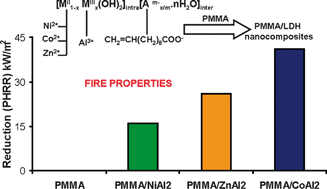Aluminum-containing layered double hydroxides: the thermal, mechanical, and fire properties of (nano)composites of poly(methyl methacrylate)†
Abstract
Hydrotalcite-like anionic clays or layered double ![[double bond, length as m-dash]](https://www.rsc.org/images/entities/char_e001.gif) CH(CH2)8COO−)x·nH2O]inter, with MIII = Al and MII = Co, Ni, Cu and Zn, have been prepared by the co-precipitation method and used to prepare nanocomposites with poly(methyl methacrylate) (PMMA). One goal of this work was to compare the morphology, thermal, fire and mechanical properties with those of the well known PMMA–montmorillonite system. The thermal properties of these systems are greatly improved relative to the virgin PMMA, with ZnAl2 and CoAl2 being the best systems when 50% mass loss is the point of comparison. NiAl2, on the other hand, is more thermally stable when 10% mass loss was the point of comparison. The mechanical properties, such as Young's Modulus and elongation, were not significantly impacted by nanocomposite formation. The cone calorimetric results showed that the PMMA–CoAl2 system gives the best reduction (41%) in peak heat release rate (PHRR); this value is significantly larger than that seen for the PMMA–montmorillonite system. Small improvements were observed for the nickel-containing LDH with the same
CH(CH2)8COO−)x·nH2O]inter, with MIII = Al and MII = Co, Ni, Cu and Zn, have been prepared by the co-precipitation method and used to prepare nanocomposites with poly(methyl methacrylate) (PMMA). One goal of this work was to compare the morphology, thermal, fire and mechanical properties with those of the well known PMMA–montmorillonite system. The thermal properties of these systems are greatly improved relative to the virgin PMMA, with ZnAl2 and CoAl2 being the best systems when 50% mass loss is the point of comparison. NiAl2, on the other hand, is more thermally stable when 10% mass loss was the point of comparison. The mechanical properties, such as Young's Modulus and elongation, were not significantly impacted by nanocomposite formation. The cone calorimetric results showed that the PMMA–CoAl2 system gives the best reduction (41%) in peak heat release rate (PHRR); this value is significantly larger than that seen for the PMMA–montmorillonite system. Small improvements were observed for the nickel-containing LDH with the same


 Please wait while we load your content...
Please wait while we load your content...